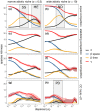A process-based metacommunity framework linking local and regional scale community ecology
- PMID: 32672410
- PMCID: PMC7496463
- DOI: 10.1111/ele.13568
A process-based metacommunity framework linking local and regional scale community ecology
Abstract
The metacommunity concept has the potential to integrate local and regional dynamics within a general community ecology framework. To this end, the concept must move beyond the discrete archetypes that have largely defined it (e.g. neutral vs. species sorting) and better incorporate local scale species interactions and coexistence mechanisms. Here, we present a fundamental reconception of the framework that explicitly links local coexistence theory to the spatial processes inherent to metacommunity theory, allowing for a continuous range of competitive community dynamics. These dynamics emerge from the three underlying processes that shape ecological communities: (1) density-independent responses to abiotic conditions, (2) density-dependent biotic interactions and (3) dispersal. Stochasticity is incorporated in the demographic realisation of each of these processes. We formalise this framework using a simulation model that explores a wide range of competitive metacommunity dynamics by varying the strength of the underlying processes. Using this model and framework, we show how existing theories, including the traditional metacommunity archetypes, are linked by this common set of processes. We then use the model to generate new hypotheses about how the three processes combine to interactively shape diversity, functioning and stability within metacommunities.
Keywords: Abiotic niche; coexistence; competition; dispersal; diversity; environmental change; functioning; stability; temporal.
© 2020 The Authors. Ecology Letters published by CNRS and John Wiley & Sons Ltd.
Figures






References
-
- Adler, P.B. , HilleRisLambers, J. & Levine, J.M. (2007). A niche for neutrality. Ecol. Lett., 10, 95–104. - PubMed
-
- Adler, P.B. , Smull, D. , Beard, K.H. , Choi, R.T. , Furniss, T. , Kulmatiski, A. et al (2018). Competition and coexistence in plant communities: intraspecific competition is stronger than interspecific competition. Ecol. Lett., 85, 1265–1311. - PubMed
-
- Alexander, J.M. , Diez, J.M. & Levine, J.M. (2015). Novel competitors shape species' responses to climate change. Nature, 525, 515–518. - PubMed
-
- Barabás, G. , Michalska‐Smith, J. M. & Allesina, S., (2016). The effect of intra‐ and interspecific competition on coexistence in multispecies communities. Am Nat, 188, E1–E12. - PubMed
-
- Bell, G. (2000). The distribution of abundance in neutral communities. Am Nat, 155, 606–617. - PubMed
MeSH terms
Grants and funding
LinkOut - more resources
Full Text Sources
Other Literature Sources

